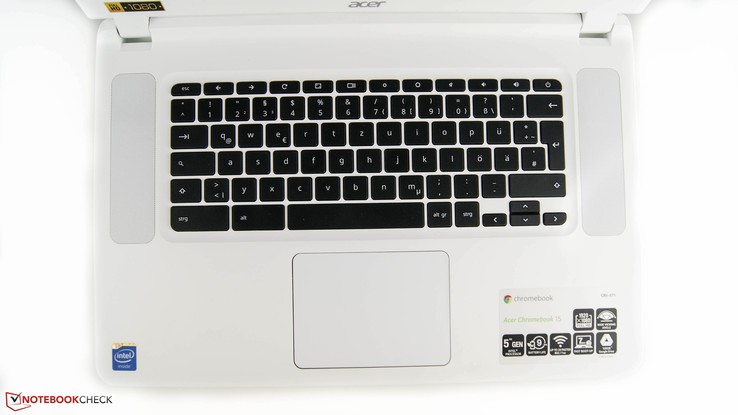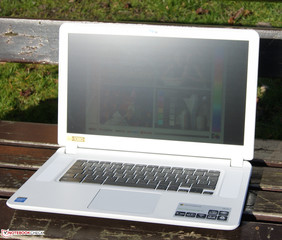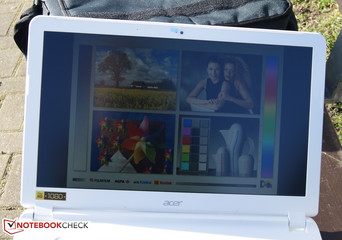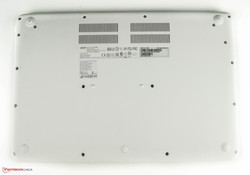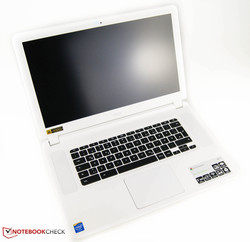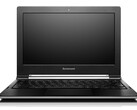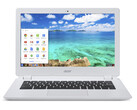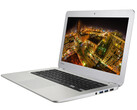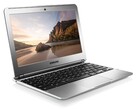Acer Chromebook 15 CB5 Review

For the original German review, see here.
A little over a week ago, Acer notified us that their new Chromebook product line is now available. In almost no time, one of the new Acer Chromebooks lay on our dissection table for a thorough examination. On their website, the manufacturer presents three different models in all. Price-wise, the models are separated by about 100 Euros each (~$108), ranging from 270 Euros (~$293) to 480 Euros (~$521). Our test device is Acer's midrange model, priced at 380 Euros (~$412). For that stack of bills, the buyer gets a Full HD IPS display, an energy-efficient Intel Celeron 3205U, 4 GB of RAM and 32 GB of SSD storage. Compared to the Chromebooks we've previously reviewed, the larger 15.6-inch display is especially attention-grabbing.
In order to find some competition for the Acer Chromebook, we'll need to step down a rung on the display-size ladder. The 14-inch HP Chromebook G1 we just reviewed seems like a particularly worthy rival. HP is asking a similar 370 Euros (~$401) for their Chromebook, equipped with an Intel Celeron 2995U, 4 GB of RAM and 32 GB of SSD storage space.
Case & Connectivity
The Chromebook's white case is quickly becoming a distinguishing feature of this line. As per usual, the Acer device's case is constructed entirely of plastic. The design makes a simultaneously modern and playful impression. Overall, the machine's manufacturing is very solid. Minor weaknesses exist in the area around the hinges, and the backside of the display and the keyboard both yield slightly under pressure. The two somewhat fragile hinges don't make an especially sturdy impression. At 1979 grams (~4.4 lbs), the Chromebook isn't too heavy to carry around with you. We were prohibited from investigating the device's maintenance and upgrade options during our testing. The 18 screws that secure the base plate are easy to unscrew, but it's fairly difficult to remove the base plate without hurting oneself in the process.
The range of connections available on the 15.6-inch device is fairly limited: The computer has just a USB 2.0 port, a USB 3.0 port, an SD-card slot and an HDMI port. However, the positioning of the ports is excellent: They are located on the back portion of the notebook, which means that the ideal workspace on a desk or table isn't occupied by cables or protruding peripheral devices.
Input Devices
Keyboard
Acer outfitted their new Chromebook with a black chiclet keyboard. All the keys are sufficiently well-attached and don't give too much when pressure is applied on the corners. Their travel length is very soft and a bit short, which means the keyboard feels a bit spongy during typing. Unfortunately, the imprinted letters on the keys are quite palpable. Even when the user is typing with abandon, the sound generated by the keyboard is comfortably quiet and deadened. As per usual with Chromebooks, the F-keys are replaced by shortcuts. These perform the same functions as the familiar Fn combinations. Unfortunately, the large notebook lacks any further special keys or a number pad.
Trackpad
We're fans of the Acer notebook's large trackpad. Fingers glide beautifully across the smooth surface. As a general rule, the pad recognizes input near the border and in the corners without a problem. The input device always executes multitouch gestures, like scrolling on websites, fluidly and without any lagging. The two built-in keys produce a clear clicking sound. The individual keys have the same rigidity from their sides all the way to their meeting point.
Display
The CB5's display deserves special attention: The device costs just 370 Euros (~$401) in the configuration we are currently examining, yet Acer made no cutbacks here. Our Acer device is equipped with an IPS panel whose screen content looks correct from every angle. To put this into perspective, the HP Chromebook is at a similar price point and only has a glossy 1366x768-pixel TN panel. When it comes to brightness, however, the Acer leaves something to be desired.
| |||||||||||||||||||||||||
Brightness Distribution: 87 %
Center on Battery: 245 cd/m²
Contrast: 613:1 (Black: 0.4 cd/m²)
The Acer Chromebook 15 can be used outdoors. The screen's maximum brightness isn't high enough to outshine the sun, but as long as the user selects shadowy environments, it should be easy to work outside. Thanks to the notebook's matte display, even when the screen is hit with direct light, the screen content isn't obscured by bothersome reflections.
Thanks to the fact that Acer chose an IPS panel for their Chromebook, the screen content looks accurate from side angles as well. From a subjective perspective, the panel's color and grayscale reproductions are highly satisfactory for a notebook in this price range. Unfortunately, due to the fact that the device only runs Chrome OS, we were unable to perform a detailed analysis of the display's color and grayscale reproductions.
Performance
Chrome OS is key here. As is widely known, the Google operating system has very low hardware demands, which is why it's capable of running on tablet CPUs. Our test device is outfitted with an x64-bit Intel Celeron 3205U processor. Those who require more performance power can opt for the version with a stronger Intel Core i3-5005U, though this upgrade costs an extra 100 Euros (~$108). The 4 GB of RAM and 32 GB of SSD storage in our test device are more common in higher-end Chromebooks. The entry-level model in the Acer CB5 line costs about 100 Euros less (~$108 less) and is outfitted with exactly half the amount of memory and storage. Due to the fact that the range of applications and functions is more limited than on a normal laptop, Chromebooks are designed to simply and effectively take care of office and Internet-related tasks.
The Intel Celeron 3205U at work in our test device is a CPU from the Broadwell line and clocks at a frequency of 1.5 GHz. According to Intel, the chip's maximum power consumption rate is 15 Watts. With its two cores, the ultra-low voltage CPU can easily handle the Google operating system.
System Performance
The large 15.6-inch Chromebook always runs fluidly and reacts quickly. Even tabs and videos don't make the system sweat. This subjective impression we gained over the course of our tests is corroborated by the results from our various benchmarks. The results are extremely positive and prove that not only is this Acer device the biggest Chromebook we've ever tested -- it's also the most powerful.
| Sunspider - 1.0 Total Score (sort by value) | |
| Acer Chromebook 15 CB5-571-C9GR | |
| HP Chromebook 14 G1 | |
| Lenovo N20 Chromebook | |
| Toshiba Chromebook CB30-102 | |
| Acer CB3-111 | |
| Octane V2 - Total Score (sort by value) | |
| Acer Chromebook 15 CB5-571-C9GR | |
| HP Chromebook 14 G1 | |
| Lenovo N20 Chromebook | |
| Toshiba Chromebook CB30-102 | |
| Acer CB3-111 | |
| Mozilla Kraken 1.1 - Total (sort by value) | |
| Acer Chromebook 15 CB5-571-C9GR | |
| HP Chromebook 14 G1 | |
| Lenovo N20 Chromebook | |
| Acer CB3-111 | |
| Peacekeeper - --- (sort by value) | |
| Acer Chromebook 15 CB5-571-C9GR | |
| HP Chromebook 14 G1 | |
| Lenovo N20 Chromebook | |
| Lenovo N20p-59426642 Chromebook | |
| Toshiba Chromebook CB30-102 | |
| Acer CB3-111 | |
| WebXPRT 2013 - Overall (sort by value) | |
| Acer Chromebook 15 CB5-571-C9GR | |
| HP Chromebook 14 G1 | |
| Lenovo N20 Chromebook | |
| Browsermark - 2.1 (sort by value) | |
| Acer Chromebook 15 CB5-571-C9GR | |
| HP Chromebook 14 G1 | |
| Lenovo N20 Chromebook | |
* ... smaller is better
Storage Devices
As most of the tasks performed in Chrome OS are done online, most Chromebooks only have a small amount of storage space. Our Acer device has 32 GB of SSD storage. Out of the 32 GB, 23 GB remains available to the user. The manufacturer had no intention of giving the user access to the SSD, so the storage space can only be increased via SD card. Unfortunately, SD cards don't quite slide all the way into the notebook and stick out on the right side of the base unit.
Graphics Card
Embedded into the CPU is an Intel HD Graphics (Broadwell) chip that is responsible for graphics tasks. The graphics unit, which has only been available since the start of the year, supports standards like OpenCL 2.0 and DirectX 11.2. However, things like DirectX 11.2 don't run in Chrome OS, which, unfortunately, means we were unable to run our benchmark programs on the test device. In everyday use, impressively, the iGPU can fluidly render several YouTube videos and externally started Full HD videos in parallel.
Emissions & Energy
System Noise
Acer's Chromebook achieved outstanding results in our noise tests. Neither in idle mode nor under load does the computer reach distinctly audible frequencies. We had to listen very closely to establish whether the machine is equipped with a fan. We wonder why Acer didn't choose to go fanless here, as they did for their Acer Chromebook 13 CB5.
Noise level
| Idle |
| 31.7 / 31.7 / 31.8 dB(A) |
| Load |
| 31.7 / 31.8 dB(A) |
 | ||
30 dB silent 40 dB(A) audible 50 dB(A) loud |
||
min: | ||
Temperature
Our test device doesn't just excel in the realm of noise levels. Even though the fan is barely noticeable, the case never grew uncomfortably hot, even when we ran a film sequence and Octane 2.0 to simulate heavy load. We measured a maximum temperature of 33 °C (91.4 °F), which was just 4 °C (39.2 °F) higher than the hotspot's temperature in idle mode.
(+) The maximum temperature on the upper side is 33.1 °C / 92 F, compared to the average of 33.1 °C / 92 F, ranging from 21.6 to 53.2 °C for the class Netbook.
(+) The bottom heats up to a maximum of 32.6 °C / 91 F, compared to the average of 36.6 °C / 98 F
(+) In idle usage, the average temperature for the upper side is 25.1 °C / 77 F, compared to the device average of 29.8 °C / 86 F.
(+) The palmrests and touchpad are cooler than skin temperature with a maximum of 27.5 °C / 81.5 F and are therefore cool to the touch.
(±) The average temperature of the palmrest area of similar devices was 29.3 °C / 84.7 F (+1.8 °C / 3.2 F).
Speakers
When we review an inexpensive device, we only expect a certain level of quality; that's why we're so pleasantly surprised by the Acer Chromebook's positive results. The computer's speakers are able to cover a reasonably wide spectrum of sound and generate the sound at a fitting volume level. However, the speakers don't produce rich bass tones. The Chromebook's sound should be adequate for the occasional film or TV show, though music lovers are better off utilizing external speakers or headphones.
Power Consumption
Even with its powerful hardware, the Acer CB5 proves to be less thirsty under load than the HP Chromebook G1. At a maximum energy consumption rate of 10.1-11.6 Watts, our test device needs about 2 Watts less than HP's Chromebook. We see a similar behavior in idle mode. Here, the Acer requires a minimum of 3.1 Watts and can use up to 7.6 Watts at maximum brightness.
| Off / Standby | |
| Idle | |
| Load |
|
Key:
min: | |
Battery Life
According to the manufacturer, the Acer Chromebook is outfitted with a 4-cell battery with a capacity of 32 Wh. For comparison: The 14-inch HP Chromebook G1 has a 51-Wh battery. Even so, at nine hours, the Acer CB5's battery life far exceeds that of the HP Chromebook.
| Battery Runtime - WiFi Websurfing (sort by value) | |
| Acer Chromebook 15 CB5-571-C9GR | |
| HP Chromebook 14 G1 | |
Pros
Cons
Verdict
The Acer Chromebook CB5 trumps its competitors in several different categories. True, the notebook is equipped with an energy-saving processor, but the chip is perfectly complemented by the amount of RAM, and it runs the Google operating system beautifully. Even though the test device is in the lead in our benchmark tables, the manufacturer offers an even more powerful CPU for an extra 100 Euros (~$108). Potential buyers won't just receive a display that can be viewed from a wide range of angles -- it's even matte. Similarly priced competitors, like the HP Chromebook G1, only offer a TN panel. The Acer device's 9-hour battery life is an important advantage as well.
All in all, Acer's 15.6-inch Chromebook is a success. Those who are content just doing office work and hopping around the Internet will find that this is an exemplary device.
Before we give the impression that there are no downsides to the Acer, let us reiterate that the keyboard and manufacturing quality leave something to be desired. The keyboard is spongy and isn't ideal for work that involves a lot of typing.
Acer Chromebook 15 CB5-571-C9GR
- 03/25/2015 v4 (old)
Nino Ricchizzi






